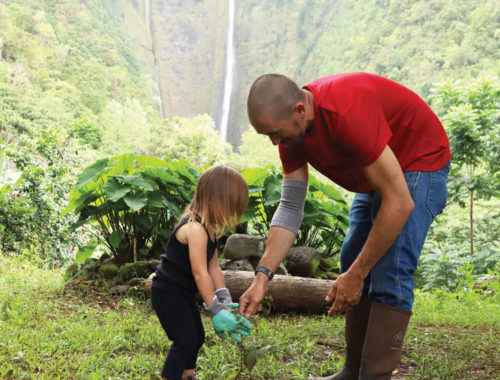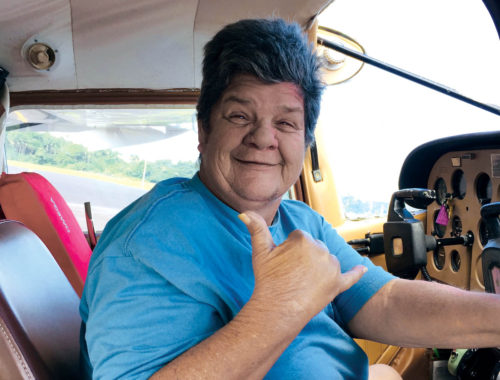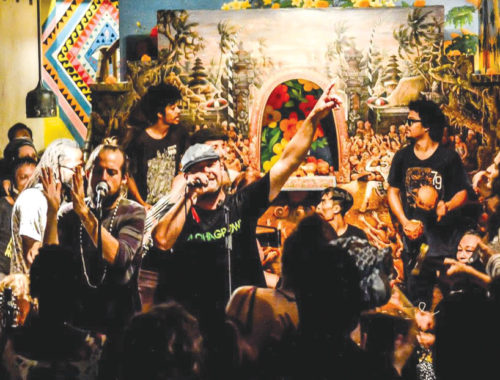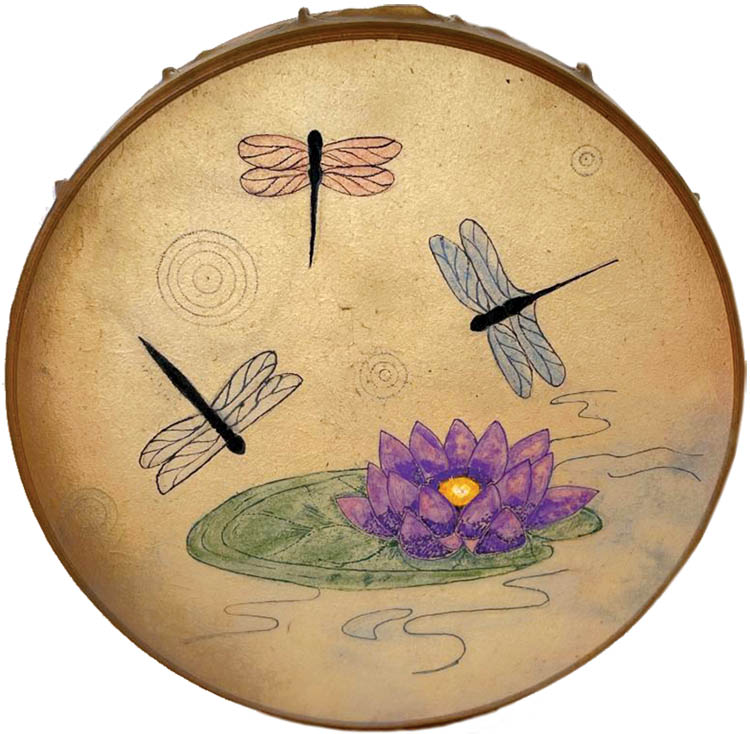
Elizabeth Theriault’s Journey with the Drum—A Pathway of Heart

By Ma‘ata Tukuafu
When Elizabeth Theriault moved to Hawai‘i in 1985 with her husband and son, she came with eagerness to integrate into the Hawaiian culture. Elizabeth, a lifelong creative artist, grew up in a diverse multi-cultural family of hunters, gardeners, beekeepers, fishermen, and cooks. Born and raised in an agricultural valley in California, and then living in Washington and Oregon, Hawai‘i Island became their long-term home.
Upon moving here, Elizabeth immersed herself into the culture by taking a Hawaiian language course, learned lauhala weaving, gourd carving, and danced hula for ten years. From the ‘Study of Hawaiian Plants and their Uses’ class at University of Hawai‘i’s Kealakekua extension program, she learned about the diversity of ancient indigenous practices in every area of life and spirituality.
Combining her career as a chef with her love for this cultural home, in 1994 Elizabeth began writing a column for Ka‘u Landing called “E Ho‘olaulea i Ka Pulapula o Ka ‘Āina” (Celebrating the Foods of Our Land). It was the same year she was hired at Kona Village Resort as a pastry chef, as well as cooking for the resort’s guests with special dietary needs. She reflects, “I thought I would be there just a year, yet the gifts of place, ‘āina, culture, and people continued to work on me in healing ways, to both strengthen and support a Hawaiian heart.” Humbleness, respect, aloha, forgiveness, and sharing sculpted her, while she worked on the sacred land of Ka‘upulehu and Kahuwai Bay.
By 1998, Elizabeth was asked to officiate weddings at Kona Village. She developed a deep relationship with the elements, combining her love of people and ceremony in culturally-related reverence. The kūpuna and co-workers were generous with their time and mana‘o (thought) which helped to deepen Elizabeth’s life. She remained there until the Fukushima tsunami closed the resort in 2011. While there, lifelong ‘ohana were gained, particularly with Leina‘ala Lightner and the Keakealani ‘ohana, who continue to share ho‘okipa and aloha with Elizabeth, supporting community throughout, including holding DrumSpeak gatherings at the cultural learning center of Kalaemano, at Ka‘upulehu.
Connecting to the Drum
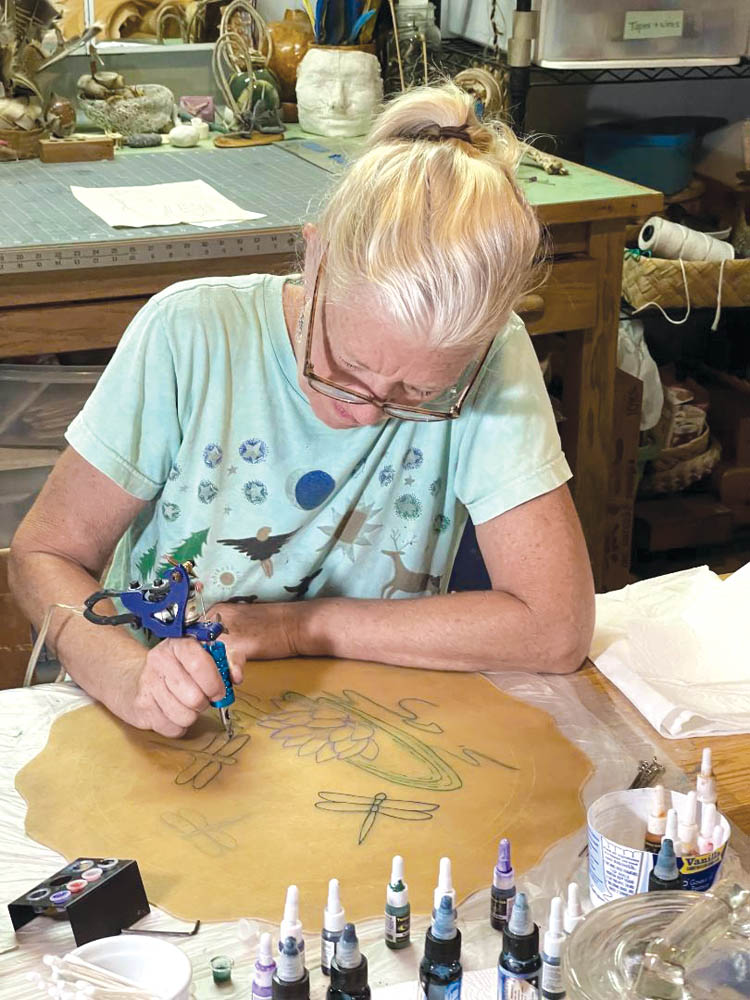
Despite her full life, Elizabeth has always made time to create art. Introduced to the Native American frame drum in 1993, she found her authentic voice through her own cultures, after making her first drum. She says she played it every day for a year amongst a variety of island topographies. This led her to participate in full and new moon ceremonies and making drums with other individuals. Her experience grew into co-leading seasonal drum ceremony circles and facilitating board and community-building groups. Years later, the path of the drum has deepened her life immensely, as well as touched countless lives of the many people who have been fortunate to meet and work with her.
In 2003, Elizabeth traveled to her homeland in the Sierra Nevadas with Leina‘ala for a week-long American Indian Women’s conference. Her experiences there were enlightening and educational. Elizabeth not only received spiritual permission to make drums in groups, she also envisioned DrumSpeak, an organization that would share ways to use the drum for healing and personal empowerment with people from diverse cultures.
The following year, Elizabeth and her husband, Gary, opened Kona Art Gallery in Holualoa, where Elizabeth’s art and drums are sold. In February 2005 she began holding monthly drum circles at the gallery (which are still active in different locations), while leading group drum making workshops. In October 2005, the first drum making program was held in Hawai‘i, with grant assistance from Healing Our Island (which provides an alternative away from drug and alcohol use). From this project at Pu‘uanahulu, 38 drums were created. DrumSpeak’s website, which Elizabeth created in 2006, visions a three-fold path of action: monthly drum circles, drum making workshops, and International Drum Day gatherings. Elizabeth shares, “One DrumSpeak activity close to my heart supports the voices of young girls and women to be heard in a purposeful way in the world through the drum.”

Mended Heart Drums
After the tragic death of a friend’s son, Elizabeth created a mended heart drum in 2009, forming yet another creative healing approach to making drums. As she says on her Blessingways website: “In inspiration, it came to me to take all the little pieces of hide from my drum and rattle makings over the years and stitch them together with prayer, love and support in a shape of a woman coming back to herself and serenity.” Since then, many Mended Heart Drums have gone to people who are grieving and healing, using the drum as a way of “finding and bringing their ‘pieces’ back home to self.” Elizabeth has learned it is vitally important to have connection and ceremony, encouraging people in small ways with expressions of love, stories, songs, or poems.
“A strong connection with good spiritual listening, required by reducing distractions, is what is going to transform and heal us,” she says. “This is what I want to spend the remaining years of my life doing. Being in daily ceremony, being prayerfully present, receiving inspiration, sensitive to synchronicities, and acting on directions given by Spirit. That’s one of the things that came to me too.”
Natural, Adorned, Painted, or Tattooing Drums
Whether by innovation or touching in with the ancient, every drum Elizabeth has made is unique with a distinct character and voice. She has left many drums unadorned, while others are painted and decorated. Sometime in 2010, an inspiration came to Elizabeth to tattoo the drum skins. “When I ‘heard’ this, I was amazed and asked myself the origins of the word tattoo,” Elizabeth explains. “Among a few definitions, I learned that a synonym for tattoo is drumbeat. I knew I had something special come to me to learn about joining the mediums and practices and to steward it in development for a while.”

She began the creative process, bringing ideas into form and experimenting with different methods of tattooing on the skins. To date she has completed 16 tattooed drums. Elizabeth’s own most personal tattooed drum relays her ‘kakau,’ a process originally shared by Kumu Raylene Kawaiaea, which reveals and helps one connect to a Divine Pattern or original blueprint.
Elizabeth says she will continue to work with the tattoo drum process, yet also thinks at 64 years, it’s time to share the seeds of this discovery for others to explore in a dedicated way. After researching to find out if anyone has tattooed on drum skins, as far as Elizabeth knows, no one has done this before. Tattooing drums has not been an easy process to learn. Animal hide texture is not always consistent, and is quite different than tattooing on human skin. She is learning by trial and error, using various types of hides and testing different methods of pattern transfer. Unlike marking and tattooing human skin which can be stretched and moved, Elizabeth says the drum hide is flaccid and must be pierced while wet. A huge part of the challenge is to keep the design from rubbing off, and she has practiced with pencil, colored pencil, and transfer and carbon papers. Drawing the designs on both sides of dry hide elevates the possibility of preserving it throughout the tattoo process.
Once the skin is soaked, the ink or tracing may rub off. Starting the tattooing by outlining everything followed by any shading throughout, results in a better outcome. When wet, the drum hides expand and contract when stretched onto the drum to finish it. In this expansion/contraction process, thinner and thicker, uneven skins provide a challenge for piercing and may create an accidental hole not seen immediately. Unlike tattooing on human skin where tattoos will heal, a deeper breakage of the animal hide won’t heal on a drum, but may tear when stretched across the drum frame making it impossible to complete the drum.
Sometimes a single needle tattoo piercing is called for and sometimes it is fine to use a tattoo machine. Elizabeth says the practice of being present with one’s work, always listening to intuition, and following ones na‘au (gut) will bring the best results. Elizabeth states, “I look forward to seeing what beauty practiced tattoo artists may bring to this sacred art form.”
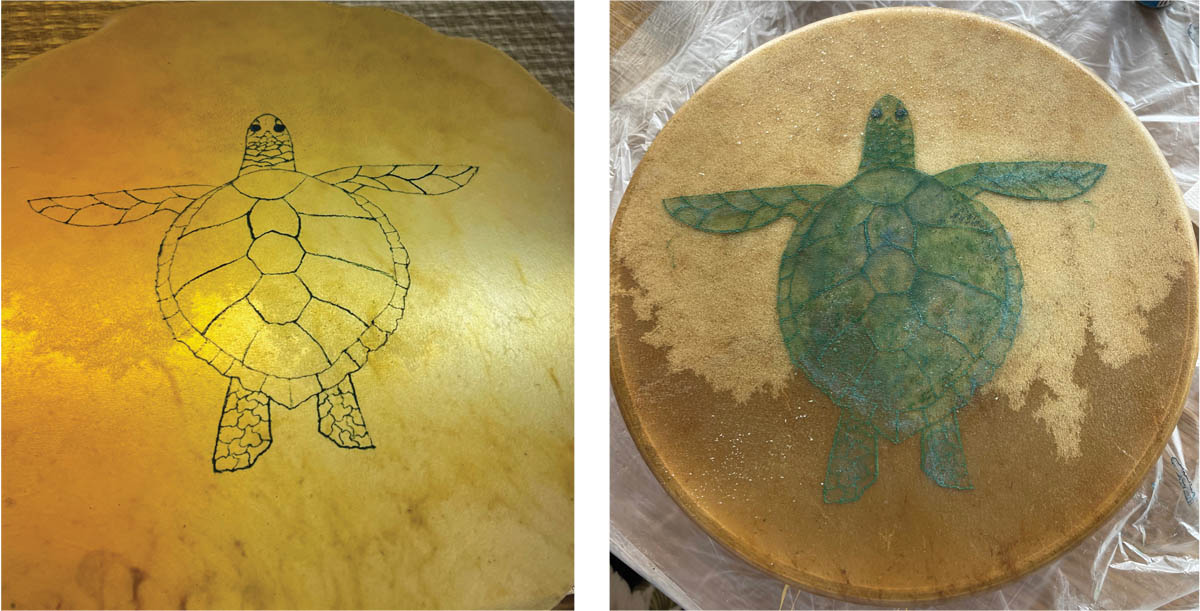
‘O ke Aloha ke Alaka‘i…Let Love Lead
Elizabeth shares, “I believe that life is a ceremony when we pray it to be.” She is happy to be fully living this now, in an integrated way. While having done many diverse art mediums over her lifetime, she has concluded that she can best be of service to herself and others by sharing ways for each of us to connect through nature, art, culture, and the natural cycles we live within.
She focuses her artistic efforts in creating ceremony and tools with this objective and for these purposes. She sums up the conversation, saying, “the largest drum that we all share is Mother Earth herself, with her own heartbeat rhythm and frequencies. We need to honor, respect, and protect her. Environmental integrity is vital for survival of all living beings at this time.” She compares her current efforts to assisting our evolving humanity and life on earth. Elizabeth’s life has been a journey of heart-encompassing art, spirituality, ‘ohana, gratitude, and aloha. She continues to lead drum making workshops for all who are inspired. This year’s DrumSpeak Peace Walk is on March 19, 2022 in Kailua-Kona. ❖

All photos courtesy of Elizabeth Theriault
For more information: drumspeak.org, worldpeacerun.org

